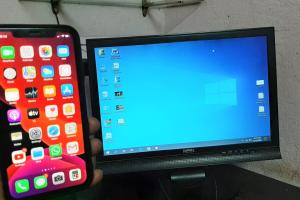Ultimate Guide: How to Connect Your iPhone to Your Computer with or Without a Cable

-
Quick Links:
- Introduction
- Connecting Your iPhone with a Cable
- Connecting Your iPhone Wirelessly
- Troubleshooting Connection Issues
- Case Studies and Real-World Applications
- Expert Insights
- FAQs
Introduction
Whether you want to transfer photos, back up data, or sync files, connecting your iPhone to your computer is essential. In this guide, we'll explore various methods to connect your iPhone—both with a cable and wirelessly—offering step-by-step instructions to ensure a seamless experience.
Connecting Your iPhone with a Cable
Step 1: Gather Necessary Equipment
You will need the following:
- Your iPhone
- A compatible USB cable (Lightning or USB-C)
- A computer (Windows or Mac)
Step 2: Connect Your iPhone to the Computer
Plug one end of the USB cable into your iPhone and the other end into a USB port on your computer. Make sure you use a working USB port to avoid connection issues.
Step 3: Trust This Computer
Upon connecting, your iPhone will prompt you to "Trust This Computer". Tap "Trust" and enter your passcode if prompted. This step allows your computer to access your iPhone's content.
Step 4: Access Your iPhone on Your Computer
For Windows:
- Open File Explorer and find your iPhone listed under "This PC".
- Double-click to access your device and transfer files.
For Mac:
- Open Finder and select your iPhone from the sidebar.
- You can now sync, back up, or transfer files through Finder.
Connecting Your iPhone Wirelessly
Step 1: Ensure Both Devices Are on the Same Wi-Fi Network
For a wireless connection, ensure your iPhone and computer are connected to the same Wi-Fi network.
Step 2: Set Up iCloud Drive
Use iCloud Drive for seamless file access. Enable iCloud Drive on your iPhone:
- Go to Settings > Apple ID > iCloud.
- Toggle on iCloud Drive.
Step 3: Access Files on Your Computer
On your computer, log in to iCloud.com using your Apple ID. You can now upload and download files directly from your iPhone.
Step 4: Use Third-Party Apps
Consider using apps like AirDrop (for Mac) or File Explorer (for Windows) to transfer files wirelessly.
Troubleshooting Connection Issues
Common Connection Problems
Here are some common issues you might face while connecting your iPhone to your computer:
- iPhone not recognized by the computer
- Trust This Computer prompt not appearing
- Slow transfer speeds
Solutions
Try the following solutions for troubleshooting:
- Check your USB cable for damage.
- Restart both your iPhone and computer.
- Update iTunes or Finder on your computer.
Case Studies and Real-World Applications
Many users have experienced various methods of connecting their iPhones to computers. Here are a few case studies:
Case Study 1: A Photographer's Experience
A photographer used a wired connection to offload high-resolution images from their iPhone to a computer for editing. This method was preferred for its speed and reliability.
Case Study 2: A Business Professional's Approach
A business professional used iCloud Drive to access important files from their iPhone on a laptop during a meeting. This wireless method allowed for flexibility without the hassle of cables.
Expert Insights
Experts recommend using a wired connection for large file transfers due to faster speeds. However, for everyday tasks, wireless options like iCloud Drive and AirDrop offer convenient solutions without the clutter of cables.
FAQs
1. Can I connect my iPhone to a computer without iTunes?
Yes, you can connect your iPhone without iTunes by using Finder on macOS Catalina and later, or through iCloud and third-party applications.
2. What should I do if my iPhone isn't recognized by my computer?
Check your USB cable, restart both devices, and ensure your software is up to date.
3. Is there a way to connect my iPhone to a computer without Wi-Fi?
Yes, using a USB cable is the most reliable method to connect without Wi-Fi.
4. Can I transfer music from my iPhone to my computer?
Yes, you can transfer music using iTunes or third-party software designed for media transfers.
5. How do I disconnect my iPhone safely?
Always eject your iPhone from your computer before unplugging the USB cable to prevent data corruption.
6. Can I use Bluetooth to connect my iPhone to my computer?
Bluetooth can be used for file transfers, but it is generally slower than using a cable or Wi-Fi connection.
7. What if I forget my iPhone passcode when prompted to trust the computer?
You will need to reset your passcode using recovery mode if you forget it.
8. How can I back up my iPhone data to my computer?
Back up using iTunes or Finder, or use iCloud for cloud storage options.
9. Are there security risks when connecting my iPhone to a public computer?
Yes, connecting to public computers can expose your data. It's best to avoid connecting to shared or public devices.
10. Can I connect multiple iPhones to one computer?
Yes, you can connect multiple iPhones to one computer, but you must trust the computer on each device separately.